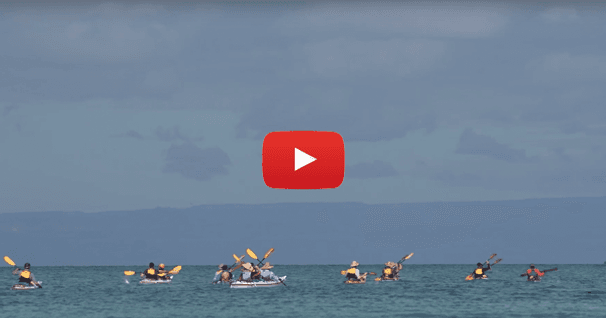Sit-On-Top Recovery
Sit-On-Tops (SOT's) are one of the many categories of boats that fall in the realm of paddle craft. As with any paddle craft you not only need to know how to maneuver it, you also need to know how to recover from a capsize. There are certain advantages to the SOT's not found in the traditional closed deck kayak. The need to empty water after a capsize is not a factor so recoveries have one less step after a wet exit.
As with any paddle craft you need to know how to do solo recoveries regardless of the number of people you have with you when you are out on the water. Sooner or later you will have to take care of yourself.
The primary solo recovery for a SOT is the BBF (bellybutton-backside-feet) recovery. The name was derived from the three main parts of the technique. You get your bellybutton over your seat. Then you flip over and put your backside in your seat. When balanced you bring your feet in. Since you have no water to pump out you are ready to paddle away.
Let's look at the details.
While you are capsizing always maintain contact with your paddle and your boat. As I will mention later in detail, I think thigh straps are nice for many reasons, one of which is a strap for you to hold onto your boat.
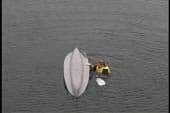
When you are ready to get back onto your SOT you have to turn it right side up. Since most SOT's are wide for added stability it will take a little more energy on your part to turn it upright. I suggest you face the side of your boat and keep your paddle in front of you under your arms. Use both hands to flip your SOT right side up but don't lose contact with it when you flip it over (thigh straps are easy to grab). When you push it over use an explosive movement. Do a scissor kick with your legs for more support.
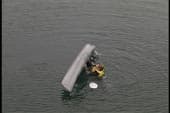
Before you climb back on your SOT be sure your straps and seat back are adjusted and in position. If you like to use a paddle leash you can have hands free while climbing back on. Also, a paddle leash will keep you in contact with your SOT if it is attached to the SOT and you hold your paddle. For this demonstration we will assume a paddle leash is not in use.
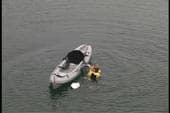
If you cannot get your paddle securely out of the way I suggest you put it to the outside of your boat (parallel to the boat) when you try to climb on. It is best if you can reach over to the other side of the boat for a secure grip. If you outfit your SOT with deck lines you will easily see the advantages when you need to climb back on.
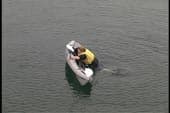
When you have a good grab on the other side of your SOT with one hand and the other hand is on your side of the SOT kick with your feet and use your arms in unison to get your body (bellybutton) over your seat. Your goal is a balanced position so you can lie over your seating area. When you are there it is a good time to take a breath or two. It is important you feel balanced rather than rushing. If you jump up too far you can end up causing a capsize in the other direction. After a few practice tries you will find your balance point.
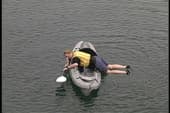
Your next step is to flip yourself over so your backside ends up in the seat. Most paddlers place the hand closest to the bow down by the edge of their boat near their thighs. This is the hand that will give you the greatest leverage for flipping your body over. The movement needs to be a decisive one because it is harder to balance when done slowly.
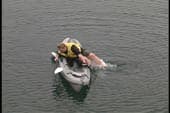
When your backside is in the seat sit there for a moment to make sure you are balanced. Many paddlers capsize at this point if they rush to bring their feet in too soon. It is perfectly fine to sit there with your feet hanging over the side. In fact I suggest you practice hanging your feet over the side while sitting sideways on your SOT.
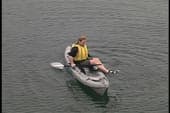
The last step is to bring one foot in at a time as you turn your body so you are facing the bow of your boat. Again, the ones who lose their balance are the ones who rush or try to bring in both feet at once.
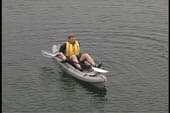
When you are on your SOT and everything is adjusted and your thigh straps are back in position (if you use thigh straps) you are ready to paddle off. Remember, there is no need to pump out the water.
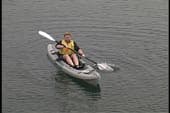
As you can see the paddler had to maintain contact with her paddle during the entire recovery. A paddle leash that attaches to the SOT would have given her hands free operation. Remember, to disconnect paddle leashes in the surf zone. Deck rigging could also provide a place to store your paddle securely when doing your recovery.
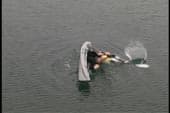
While not having to pump out water is an advantage to SOT's it can also be a disadvantage depending on how you capsize. I have seen a number of paddlers fall away from their SOT when they capsize. If the SOT does not flip over it can actually shoot away from the paddler who is now in the water. If it is a windy day the SOT can get away from you very quickly. You may find yourself swimming after your boat. I suggest you move quickly because unoccupied SOT's move quickly on windy days. If you don't know how to paddle swim I suggest you practice. This is the main reason I keep mentioning paddle leashes that attach to your SOT.
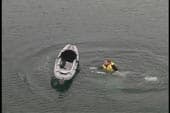
Remember, if you begin to capsize on your SOT grab for the boat. Outfitting your SOT with deck lines gives you something else to grab so your boat doesn't get away from you.
I strongly recommend that you use thigh straps when paddling a SOT. They not only give you something to hold on to during recoveries they allow you to get more performance out of your SOT. Edging and leaning allows one to get more maneuverability out of their paddle craft. Thigh straps on a SOT give you more stability in addition to greater maneuverability.
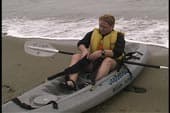
Once you relax your legs the thigh straps come right off your thighs.
If you paddle a SOT I highly recommend you master the BBF Recovery. Your goal is to be self sufficient whenever possible. If someone else is there to help all the better for you, but a solo recovery is usually inevitable. When you get good, you will be able to recover in a surf zone before the next wave is upon you.
Whether you paddle a SOT or a closed deck boat I think it is important to cross train because you never know when you may have to switch boats with someone in your group. The BBF can also be done in a closed deck kayak but putting the feet in last may be difficult for some with long legs or small cockpits.
One last comment about SOT's, some of them ride high above the water thus making it difficult to climb onto the boat to do the BBF. In such a case you try the scramble recovery (the SOT scramble recovery follows the same principles as the one used for closed deck boats.)
Wayne Horodowich, founder of The University of Sea Kayaking (USK), writes monthly articles for the USK web site. In addition, Wayne has produced the popular "In Depth" Instructional Video Series for Sea Kayaking.
Related Articles
Whenever you're paddling, there's safety in numbers and so it's generally not a good idea to paddle…
River obstacles are serious hazards on any waterway - from placid, slow-moving streams to raging,…
What's the best way to quiet a novice paddling class? Mention the "Eskimo Roll." Nothing worries…

